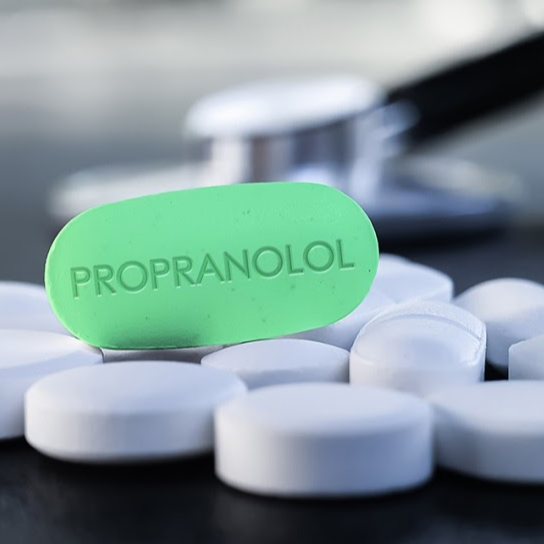Propranolol (with brand names such as Inderal, Inderal LA, Inderal XL, InnoPran XL, and Hemangeol) is a beta-blocker medication that directly affects heart activity and circulation, primarily targeting irregular heart rhythms and high blood pressure. This medication is used to treat tremors, angina (chest pain), hypertension, cardiac disorders such as arrhythmias, and circulatory problems. Additionally, Propranolol is effective in preventing heart attacks and reducing the severity and frequency of migraines.
Hemangeol (oral solution of propranolol at 4.28 mg) is prescribed for the treatment of a genetic condition called hemangioma in infants at least 5 weeks old and weighing more than 2 kilograms. Hemangioma results from the abnormal growth of blood vessels, causing red spots or sores on the skin and potentially leading to complications in the liver, brain, or gastrointestinal tract. Propranolol should not be used if you have asthma or certain heart conditions such as sick sinus syndrome (a condition associated with irregular heart rhythms).
What to Consider Before Taking Propranolol?
If you are allergic to propranolol or have a very slow heart rate, consult your doctor before taking this medication. Certain medical conditions may interfere with the use of propranolol, such as:
- Bronchitis, emphysema, or other breathing disorders
- Low blood sugar or diabetes (Propranolol may affect blood sugar detection)
- Bradycardia (slow heart rate) and low blood pressure
- Congestive heart failure (where the heart cannot pump blood effectively to meet the body’s needs)
- Depression
- Liver or kidney diseases
- Thyroid disorders
- Pheochromocytoma (adrenal gland tumor)
- Circulation issues such as Raynaud’s syndrome
The impact of this medication on pregnancy is not well-established, so consult your doctor if you are pregnant or planning to become pregnant. Propranolol can pass into breast milk and potentially harm a nursing infant, so discuss its use with a specialist if you are breastfeeding.
How to Take Propranolol?
Take Propranolol exactly as prescribed by your doctor, without altering the dosage or duration. Your doctor may adjust the dosage to ensure optimal results. Propranolol can be taken with or without food, but consistency is key—take it the same way and at the same time every day.
Dosages for Hemangeol (oral solution for children) are based on the child’s weight, and any weight change may affect the dose. Shake the bottle before use, and administer during or after feeding, ensuring at least 9 hours between doses. Maintain a regular feeding schedule and report any changes in the infant’s weight to the doctor. If vomiting or decreased appetite occurs while using Hemangeol, inform your doctor.
Before undergoing any surgery, inform your doctor about taking propranolol, as its use may need to be temporarily stopped. Propranolol should ideally be discontinued gradually, as abrupt cessation can be dangerous.
If using propranolol for high blood pressure, continue taking it even if you feel well. Hypertension often presents no symptoms and may require lifelong treatment. Combining propranolol with a comprehensive treatment plan, including diet, exercise, and weight management, can enhance its effectiveness in managing hypertension. Regular monitoring of blood pressure is recommended during treatment.
What Happens If I Miss a Dose?
For short-acting propranolol (3–6 hours effectiveness), take the missed dose as soon as remembered unless it is less than 4 hours before the next dose. For long-acting propranolol (e.g., Inderal LA or InnoPran XL, lasting up to 24 hours), take the missed dose as soon as remembered unless it is less than 8 hours before the next dose. Do not take extra medication to compensate for a missed dose.
What Happens If I Overdose?
Contact your doctor or emergency services immediately. Symptoms of an overdose may include a slow or irregular heartbeat, dizziness, weakness, or fainting.
What Should I Avoid While Taking Propranolol?
Avoid alcohol, as it may increase blood propranolol levels. Avoid sudden movements like quickly standing up from a sitting or lying position to prevent dizziness.
Side Effects of Propranolol
Common side effects of propranolol may include nausea, vomiting, diarrhea, constipation, stomach cramps, reduced libido, erectile dysfunction, sleep disturbances (insomnia), and fatigue.
Seek emergency care if you experience signs of an allergic reaction to propranolol, such as hives, difficulty breathing, or swelling of the face, lips, tongue, or throat. Contact your doctor immediately if you notice the following symptoms:
- Slow or irregular heartbeat
- Severe weakness
- Wheezing, breathing difficulties, or shortness of breath
- Swelling
- Rapid weight gain
- Vision problems or loss of coordination
- Cold sensation in hands and feet
- Depression, confusion, or hallucinations
- Liver problems (e.g., nausea, upper stomach pain, itching, fatigue, dark urine, clay-colored stool, or yellowing of the skin or eyes)
- Low blood sugar (e.g., headache, hunger, sweating, dizziness, rapid heart rate, or irritability)
- Signs of low blood sugar in infants, such as pale or bluish skin, sweating, coughing, crying, lack of appetite, cold sensation, drowsiness, weakness, breathing difficulties, seizures, or loss of consciousness
- Severe skin reactions in children, such as fever, sore throat, facial or tongue swelling, red or purple skin rash (especially on the face or torso), blistering, or peeling skin
Drug Interactions with Propranolol
Inform your doctor about all medications you are taking, as propranolol may interact with the following:
- Blood thinners like warfarin, Coumadin, or Jantoven
- Medications for hypertension
- Medications for prostate disorders (e.g., doxazosin, prazosin, terazosin)
- Heart or blood pressure medications such as amiodarone, diltiazem, propafenone, quinidine, or verapamil
- NSAIDs (e.g., aspirin, ibuprofen, naproxen, celecoxib, diclofenac, indomethacin, meloxicam)
- Steroid medications like prednisone












Our Customers' Comments
No comments registered